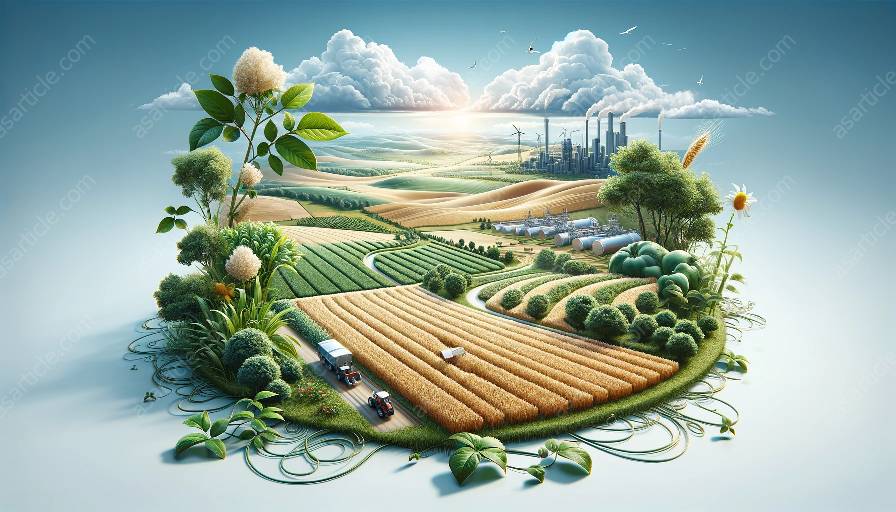With the increasing frequency and severity of droughts, the agricultural industry is facing significant challenges. Drought has a profound impact on crop production, livestock farming, and overall agricultural productivity. In this topic cluster, we will explore the adverse effects of drought on agriculture, focusing on the intersection of agricultural meteorology and climatology with agricultural sciences. We will delve into the strategies and technologies that can help mitigate the impact of drought on agriculture, highlighting the crucial role of agricultural meteorology and climatology in addressing this pressing issue.
The Impact of Drought on Agriculture
Drought is a natural disaster characterized by a prolonged period of abnormally low rainfall, resulting in water scarcity and soil moisture deficits. The agricultural sector is particularly vulnerable to the detrimental effects of drought, which can lead to widespread crop failure, reduced livestock productivity, and economic hardships for farmers.
The effects of drought on agriculture are multifaceted, impacting various aspects of the industry:
- Crop Production: Drought reduces soil moisture, hindering germination, and stunting crop growth. It leads to reduced yields, poor quality of produce, and in severe cases, complete crop failure.
- Livestock Farming: Water scarcity and diminished forage availability during droughts can severely affect livestock, leading to decreased feed quality, lower weight gain, and increased susceptibility to diseases.
- Economic Consequences: Droughts cause financial strain for farmers due to decreased crop yields and increased input costs, impacting the sustainability of agricultural operations.
- Environmental Impact: Drought exacerbates soil erosion, reduces biodiversity, and contributes to desertification, posing long-term ecological challenges for agricultural landscapes.
Agricultural Meteorology and Climatology
Agricultural meteorology and climatology play pivotal roles in understanding and managing the impacts of climatic variability, including drought, on agriculture. These disciplines integrate meteorological and climatic data with agricultural practices to improve crop yields, enhance water management, and mitigate risks associated with adverse weather conditions.
Key areas of focus within agricultural meteorology and climatology include:
- Weather Monitoring and Forecasting: Utilizing advanced meteorological technologies to monitor weather patterns and provide accurate forecasts of precipitation, temperature, and other climatic factors crucial to agricultural planning and decision-making.
- Climate Change Adaptation: Studying the long-term climate trends and their effects on agricultural ecosystems to develop adaptation strategies that help farmers and agribusinesses cope with changing environmental conditions.
- Water Resource Management: Assessing water availability, evapotranspiration rates, and irrigation needs based on climatic data to optimize water usage and ensure sustainable agricultural practices.
- Crop Modeling: Using meteorological and climatological data to simulate the growth, development, and yield potential of crops, aiding in the optimization of planting dates, crop selection, and agronomic management.
Drought Mitigation Strategies in Agriculture
Addressing the challenges posed by drought in agriculture requires a multidimensional approach that incorporates the expertise of agricultural scientists, meteorologists, and climatologists. Several strategies and technologies have been developed to mitigate the impact of drought on agricultural production:
- Drought-Resistant Crop Varieties: Agricultural scientists are developing and breeding crop varieties with enhanced drought tolerance, enabling them to withstand water stress and maintain productivity in arid conditions.
- Improving Soil Health: Implementing soil conservation and management practices, such as no-till farming and organic matter enrichment, to enhance soil water retention capacity and resilience to drought.
- Smart Irrigation Technologies: Leveraging precision irrigation techniques and sensor-based water management systems to optimize water usage and minimize wastage, particularly in drought-prone regions.
- Weather Index-Based Insurance: Utilizing meteorological data to design insurance products that provide financial protection to farmers against crop losses caused by drought and other weather-related perils.
- Climate-Smart Agriculture: Implementing climate-resilient farming practices that integrate meteorological and climatological insights to improve productivity, preserve natural resources, and adapt to changing climatic conditions.
Conclusion
As the frequency and severity of droughts continue to pose challenges for agricultural systems worldwide, the convergence of agricultural meteorology and climatology with agricultural sciences becomes increasingly crucial. By leveraging advanced technologies, scientific knowledge, and interdisciplinary collaboration, the agricultural industry can adapt and thrive in the face of drought. Mitigating the impact of drought on agriculture requires a holistic approach that integrates innovative solutions based on meteorological and climatological insights, paving the way for a more resilient and sustainable agricultural future.

